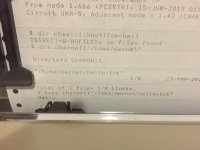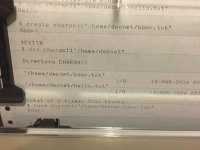NF6X
Veteran Member
It's supposed to be cold and rainy tomorrow, so I'm thinking that it might be a good time to fire up my VAX-11/730 again. If I remember correctly, it has OpenVMS 7.3 on the R80, and VMS 5.2 on an RL02 pack. After my previous adventures getting it to bootstrap from tu58em running on a Mac, I can boot the system from either drive.
I want to find some way to dump out images of the drives and get the data onto my modern machines before changing much of anything, other than the changes I've made already to update VMS licenses and so forth. Once I manage to image the current contents of the drives, I'd like to start from scratch installing some VMS version that's roughly contemporary to the machine, and then build up from there as I learn VMS.
I've made tape backups of unknown quality on the system's TU80 drive, but I do not yet have any way to read those tapes on my modern machines. I've also spent one afternoon trying to bring up TCP/IP networking several months ago, but I didn't succeed. I don't know yet whether the ethernet card, AUI cable and 10base-T transceiver are good. I don't know for sure if the right software is on the machine to talk TCP/IP, though it did seem to be responding in a sane manner to my attempts to bring up TCP/IP. And on top of that, I'm a real VMS noob, so I still have a big learning curve to climb. All I know so far is that I didn't manage to get a ping to work in either direction.
I have a broken 9-track drive with a SCSI interface that I plan to fix one of these days, so maybe that will provide a way to get data off the VAX and onto my modern machines. But I think it'll be a while before I fix the drive and get it talking to one of my "newer" machines with SCSI interfaces (Sun Ultra 60 running Solaris 8, Amiga 3000, or a ratty old 386 clone running DOS 6.22).
I have a TK50 drive and a SCSI TK30 drive; I was thinking of rigging up the TK50 to the VAX and hooking the TK30 to one of my newer machines. But trying to get the TK30 to work has been a dismal failure so far. I can share pictures of oxide-shedding tape tangled up inside the drive if anybody would like.
I wonder if any of the VAX/VMS experts here might have suggestions about good ways to go about dumping the contents of these disks? Should I continue trying to make TCP/IP work, or would I be better off trying to bring up DECNET and setting up some other machine (maybe a Linux box?) to act as a bridge between the VAX and my modern systems? Or maybe I should try yet some other scheme to hook up some other form of portable storage to the VAX? Hmm, I don't recall whether I acquired a UNIBUS SCSI card before I closed down my eBay account last year. If I have one in the pile, maybe that will offer options, such as hanging a SCSI2SD off the machine.
Assuming I manage to interface portable storage to the VAX or get a suitable communication channel working, I'll probably also need some help learning how to dump raw blocks from the drives, e.g. doing something equivalent to "dd if=/dev/somedisk of=somefile". I really don't know my way around VMS yet, and I find it a whole lot less intuitive than UNIXes. But I do want to learn VMS, and that's one of my reasons for playing with this cool VAX!
So, can anybody suggest a good direction for me before my next bout of exploratory fumbling?
I want to find some way to dump out images of the drives and get the data onto my modern machines before changing much of anything, other than the changes I've made already to update VMS licenses and so forth. Once I manage to image the current contents of the drives, I'd like to start from scratch installing some VMS version that's roughly contemporary to the machine, and then build up from there as I learn VMS.
I've made tape backups of unknown quality on the system's TU80 drive, but I do not yet have any way to read those tapes on my modern machines. I've also spent one afternoon trying to bring up TCP/IP networking several months ago, but I didn't succeed. I don't know yet whether the ethernet card, AUI cable and 10base-T transceiver are good. I don't know for sure if the right software is on the machine to talk TCP/IP, though it did seem to be responding in a sane manner to my attempts to bring up TCP/IP. And on top of that, I'm a real VMS noob, so I still have a big learning curve to climb. All I know so far is that I didn't manage to get a ping to work in either direction.
I have a broken 9-track drive with a SCSI interface that I plan to fix one of these days, so maybe that will provide a way to get data off the VAX and onto my modern machines. But I think it'll be a while before I fix the drive and get it talking to one of my "newer" machines with SCSI interfaces (Sun Ultra 60 running Solaris 8, Amiga 3000, or a ratty old 386 clone running DOS 6.22).
I have a TK50 drive and a SCSI TK30 drive; I was thinking of rigging up the TK50 to the VAX and hooking the TK30 to one of my newer machines. But trying to get the TK30 to work has been a dismal failure so far. I can share pictures of oxide-shedding tape tangled up inside the drive if anybody would like.
I wonder if any of the VAX/VMS experts here might have suggestions about good ways to go about dumping the contents of these disks? Should I continue trying to make TCP/IP work, or would I be better off trying to bring up DECNET and setting up some other machine (maybe a Linux box?) to act as a bridge between the VAX and my modern systems? Or maybe I should try yet some other scheme to hook up some other form of portable storage to the VAX? Hmm, I don't recall whether I acquired a UNIBUS SCSI card before I closed down my eBay account last year. If I have one in the pile, maybe that will offer options, such as hanging a SCSI2SD off the machine.
Assuming I manage to interface portable storage to the VAX or get a suitable communication channel working, I'll probably also need some help learning how to dump raw blocks from the drives, e.g. doing something equivalent to "dd if=/dev/somedisk of=somefile". I really don't know my way around VMS yet, and I find it a whole lot less intuitive than UNIXes. But I do want to learn VMS, and that's one of my reasons for playing with this cool VAX!
So, can anybody suggest a good direction for me before my next bout of exploratory fumbling?


